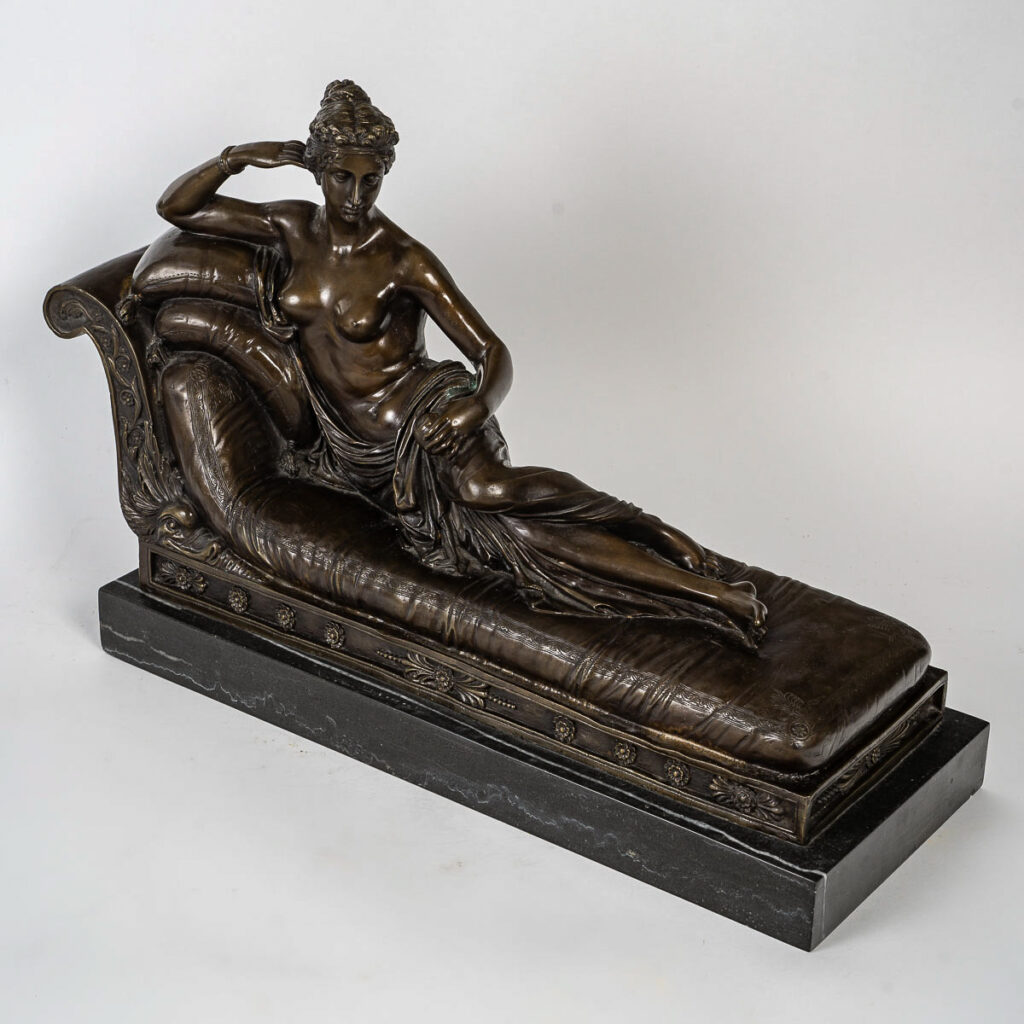After Antonio Canova (1757-1822) - Pauline Borghese dite Venus Vitrix in bronze and marble circa 1860-1880
Stamp of Bronze Garanti Paris J.B Déposé n° A 1149, a guarantee of quality that renders this splendid bronze after Antonio Canova by Pauline Borghese, known as Venus Vitrix, highly sought-after by discerning collectors.
Sculpted between 1805 and 1808 by the famous sculptor Canova, this Venus was commissioned by Camille Borghese, Pauline Bonaparte's second husband. It depicts a victorious Venus, her body unveiled, reclining in the antique style on a klinê, languidly leaning on a cushion, holding an apple evoking the judgment of Pâris.
Taking as its model the princess who posed nude for the sculpture, the work caused a scandal. The original, sculpted in Rome, was later placed in the Borghese Gallery, while a replica is now housed in the British Embassy, the princess's former private residence. Pauline posed with the sculptor again for the Galatea.
High quality in this finely chased bronze with a beautiful brown patina resting on a beautiful veined gray marble. French work bearing the guarantee stamp of the Bronzier de Paris n° A 1149 circa 1860-1880.
Sizes: H 13.77 Inches - W 21.25 Inches - D 7.48 Inches.
In very fine condition, our bronze shows minor patina wear, which contributes to the charm of this sculpture.
Biography:
Antonio Canova was a Venetian sculptor and painter, born on November 1, 1757 in Possagno and died on October 13, 1822 in Venice.
Born in Possagno, a possession of the Republic of Venice, into a family that had been stonemasons for generations, he learned the art of marble carving from an early age.
In 1768, on the recommendation of Senator Giovanni Falier, he was apprenticed to the sculptor Giuseppe Bernardi in Pagnano, before entering the Santa Marina School in Venice.
After being awarded several prizes at the Academy of Fine Arts in Venice, he went on to produce several works that soon put him at the forefront of modern sculptors, in which he combined the imitation of nature with the ideal beauty of antiquity.
He studied ancient art and, throughout his life, sculpted various statues inspired by Greek and Roman mythologies, as well as cenotaphs, busts, and full-length statues of various famous figures of the time.
He is renowned for the delicacy of his marble sculptures. His work is considered the archetype of neoclassical sculpture and has been the subject of several studies by Mario Praz.
He devoted much of the fortune he earned from his art to charitable activities or to supporting young artists or artists in need.
He was also a successful painter. Called to Paris several times by Napoleon, he returned in 1815, commissioned by the Pope to preside over the recognition and translation of monuments removed from Rome and claimed by the papal government in application of the clauses of the Congress of Vienna. Together with Dominique Vivant Denon, he was responsible for negotiating the restitution by France of Italian works of art stolen by Napoleon's army.
He was knighted and received several honors.
On his death in 1822, his heart was placed in the Venetian church of Santa Maria Gloriosa dei Frari, in a funerary monument of his creation, although he had originally dedicated it to the painter Titian. His remains are buried in Possagno, in the Tempio Canoviano, where his brother is also buried.
Bronze Garanti Paris J.B Déposé A 1149:
The Bronze stamp, Garanti Paris J.B. Déposé, is an indication of the quality and origin of a bronze sculpture. It is often associated with renowned Parisian foundries, such as the Susse Frères foundry, the Barbedienne foundry, and the Thiébaut Frères foundry. Bronze sculptures bearing this stamp are sought-after collector's items.




